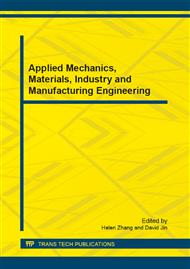p.247
p.251
p.255
p.259
p.263
p.268
p.272
p.276
p.280
Recovery of Precious Metal Material Ni from Nickel Containing Wastewater Using Electrolysis
Abstract:
The recovery of Ni2+ from nickel containing solution is a worthwhile work, owing to its precious value. In the present work, the optimal values of electrolysis (EL) operating parameters were elaborately investigated using Taguchi approach. The effect of Ni2+ initial concentration, boric acid, pH, and voltage were investigated in terms of nickel recovery and energy consumption. The results obtained showed that the influential factors on nickel recovery were voltage > boric acid > pH > concentration. However, in terms of energy consumption the following order of concentration > boric acid > pH > voltage was obtained. A confirmation experiment was carried out with the optimized parameters (boric acid 18g/L, nickel concentration 1000 mg/L, voltage applied 4.0 V, and pH 4). The recovery of Ni2+ yielded about 88%, and the outlet Ni2+ was as low as 119 mg/L. The electrolysis dynamic mode was investagated with flow rate 20 mL/min. The results showed that the outlet nickel concentration was 350 mg/L equal to 65% of Ni2+ recovery and energy consumption of 25.7 kW h/kg. Electrolysis could effectively recover nickel, however the Ni2+ concentration of the residual electrolyte was much higher than the restriction of 1 mg/L, so we used electrodialysis to further treat the residual electrolyte and the nickel concentration has been reduced below 1 mg/L , which will be discussed in other paper.
Info:
Periodical:
Pages:
263-267
Citation:
Online since:
April 2012
Authors:
Price:
Сopyright:
© 2012 Trans Tech Publications Ltd. All Rights Reserved
Share:
Citation:


